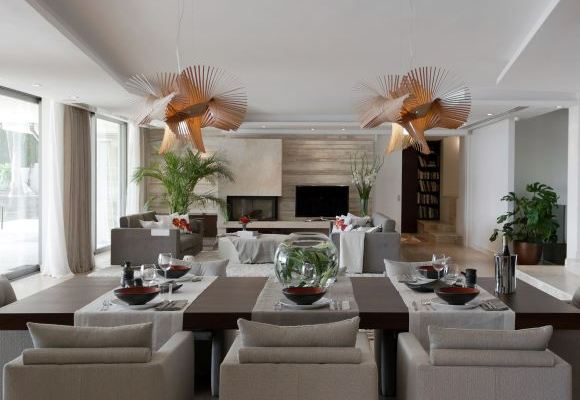Dining room lighting is designed to offer a blend of both form and function, bringing brightness and openness to a space, while imbuing it with distinct style and design that doesn’t overpower. We’ve put together a selection of our top lighting picks to anchor your favorite dining area in a variety of covet-worthy styles.
Modern Recessed Lighting

7 Lighting Ideas to Brighten Up Your Favorite Dining Space

Kitchen Island Lighting in 4 Simple Steps
Smart planning is the key to installing supremely functional and visually delectable kitchen island lighting.
Use Recessed Lighting to Brighten Up Your Modern Home
Recessed lighting, by definition, is lighting that is installed into a surface—whether it be a ceiling, wall, or floor—so that it sits flush with that surface. Modern LED recessed lighting is designed to be visually subtle, with only the recessed lighting trim visible to provide a clean and contemporary finish.
Contemporary recessed lighting plays an essential role in various interior lighting schemes, offering both primary illumination and ambient or task-related lighting. Thanks to its versatility, designer recessed lighting is suitable for a wide range of applications. If you're considering a recessed lighting installation for your home, here are some key factors to consider:
Where Does Modern LED Recessed Lighting Look Best?
While contemporary recessed lights, often referred to as can lights, can be installed almost anywhere, they work particularly well in certain spaces. As a primary lighting source, LED can lights excel in narrow or awkward areas where other fixtures might be too obtrusive or impractical.
For instance, hallways are an excellent place for recessed lighting. Thoughtfully selected designer recessed lighting trim can enhance the functionality and aesthetics of these transitional spaces. Other ideal locations include bathrooms with low ceilings, compact loft spaces, or kitchens where recessed lighting can complement other modern fixtures.
In larger rooms, recessed lighting can be strategically placed along the perimeter to provide supplementary illumination where the primary light source may not reach effectively. Additionally, LED recessed lighting is a great tool for accentuating architectural details, showcasing art collections, or drawing subtle attention to specific design elements. However, it's crucial that these subsidiary lights enhance rather than compete with the main lighting source, ensuring a harmonious overall lighting scheme.
How Many Modern LED Can Lights Are Ideal?
Determining the right number of recessed lights for a given space depends on several factors, including room size, ceiling height, and the desired lighting effect. While it may seem logical to install as many lights as possible, quality should always take precedence over quantity.
Modern recessed lighting is highly efficient and can produce ample illumination. The key is to focus on proper placement and spacing, ensuring even light distribution while avoiding overly bright or shadowy areas. Thoughtfully selected recessed lighting trim can further enhance the aesthetic appeal and functionality of your setup.
How Important Are Recessed Lighting Dimmers?
Dimmers play a crucial role in any modern lighting design, including recessed lighting. LED lights can sometimes emit harsh or overly bright light, making dimmers an essential component for creating a more adaptable and inviting ambiance.
Without dimmers, your lighting options become limited, potentially undermining the overall design and comfort of a space. Installing dimmers allows for greater flexibility, enabling you to adjust the brightness according to the time of day, mood, or specific activity. This small addition can make a significant impact on the effectiveness of your recessed lighting setup.
Frequently Asked Questions (FAQs) About Recessed Lighting
1. What is the difference between recessed lighting and regular ceiling lights?
Recessed lighting is installed flush with the ceiling, creating a sleek, unobtrusive look, whereas regular ceiling lights are surface-mounted and can take up more visual space.
2. Can recessed lighting be used in all rooms?
Yes, recessed lighting is versatile and can be used in kitchens, living rooms, bedrooms, bathrooms, hallways, and even outdoor spaces, provided it is rated for wet or damp locations where necessary.
3. What type of bulbs are best for recessed lighting?
LED bulbs are the best choice for recessed lighting due to their energy efficiency, long lifespan, and range of color temperatures to suit different ambiances.
4. How far apart should recessed lights be placed?
A common rule of thumb is to divide the ceiling height by two to determine the spacing. For example, in an 8-foot ceiling, lights should be spaced approximately 4 feet apart for even distribution.
5. Can recessed lighting be installed on sloped ceilings?
Yes, special recessed lighting housings are available for sloped ceilings to ensure proper light direction and performance.
6. Do recessed lights need to be fire-rated?
In some cases, particularly when installed in ceilings that act as fire barriers, fire-rated recessed light fixtures may be required to comply with building codes.





